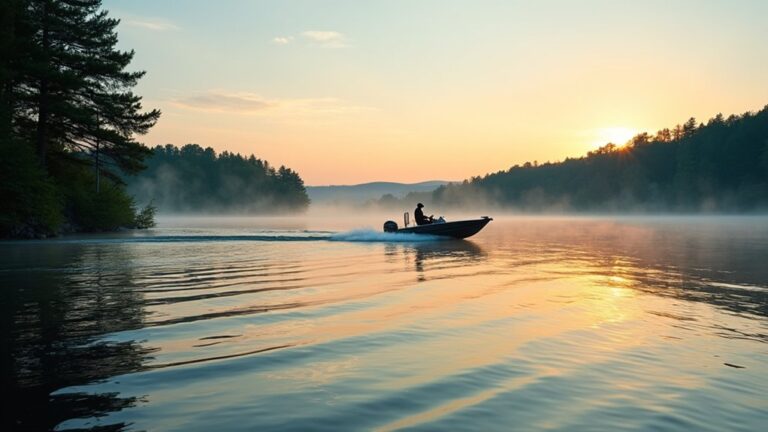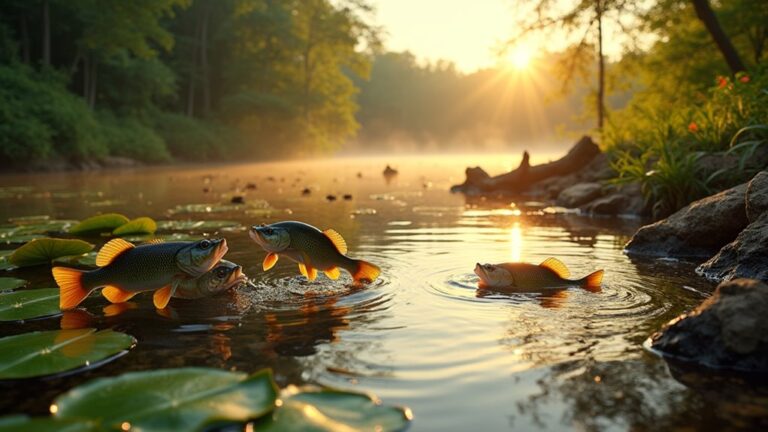Trout move between streams throughout the year to survive and thrive in changing conditions. You'll find these adaptive fish seeking ideal water temperatures (45-60°F), following prey availability, and searching for safe spawning grounds. During summer, they'll head to cooler, deeper waters and spring-fed tributaries, while winter drives them to sheltered pools for energy conservation. They'll migrate several miles upstream during spawning season and constantly adjust their location based on oxygen levels, predator threats, and available cover. Understanding these seasonal patterns can make you a more successful angler and stream observer.
Seasonal Water Temperature Changes
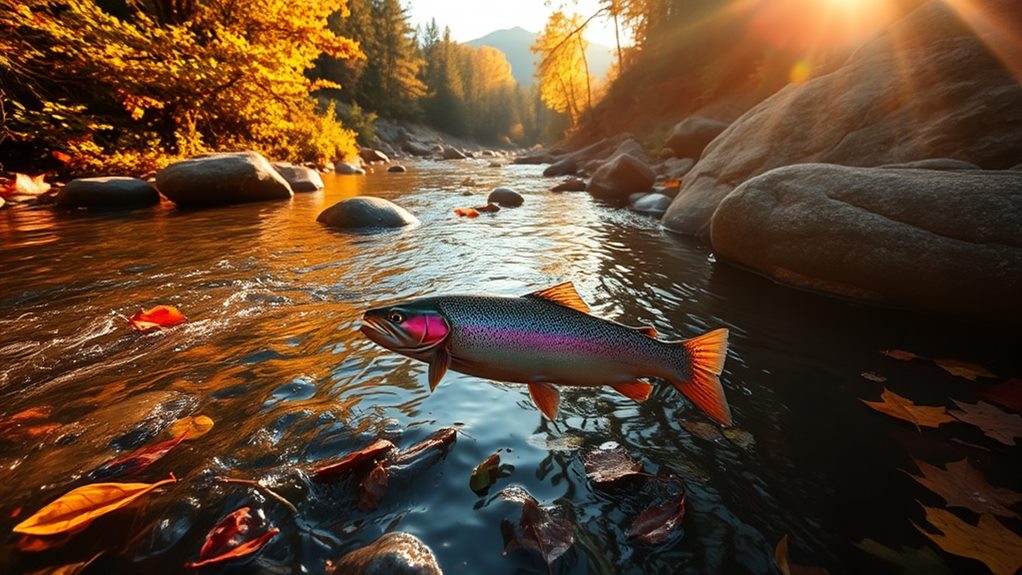
Throughout the year, water temperature changes drive trout behavior and movement patterns across different stream sections. You'll notice that as seasons shift, these remarkable fish adapt their locations and habits to maintain ideal conditions for survival.
Rainbow trout waters stay between 45-60°F for ideal activity and feeding patterns, making temperature a critical factor in their movement. During winter months, you'll find trout less active as cold water temperatures slow their metabolism. They'll conserve energy by reducing movement and feeding less frequently.
As spring arrives, you'll observe a dramatic change – rising water temperatures spark increased activity, and you're likely to spot trout actively feeding on emerging insect hatches.
In summer, when streams warm up considerably, you'll see trout relocating to survive. They'll seek refuge in deeper pools or shaded areas where cooler, oxygen-rich water provides relief from the heat.
Come fall, the cooling water temperatures trigger another behavioral shift – trout become more selective in their feeding patterns and start moving downstream to find stable winter habitats.
Understanding these temperature-driven changes helps you predict where trout might be throughout the year:
- Winter: Deep, slow pools
- Spring: Feeding zones near insect hatches
- Summer: Cool, shaded areas
- Fall: Shifting zones heading downstream
Prey Availability Throughout The Year
While water temperature drives trout movement, the availability of prey plays an equally compelling role in their seasonal stream changes.
You'll find that successful trout fishing often depends on understanding these prey-driven migrations, as the fish follow their food sources throughout the year.
In spring, you'll notice trout gravitating toward streams teeming with newly hatched mayflies and stoneflies, making these locations prime fishing spots.
As summer arrives, they'll shift their attention to streams where terrestrial insects become more prevalent, adapting their feeding patterns to match the changing prey availability.
Fall brings another significant change, as trout move to deeper pools where they can more easily ambush minnows and other slower-moving prey.
The clearer water conditions during this season make these hunting grounds particularly attractive to hungry trout.
When winter sets in, you'll find these adaptable fish congregating in streams with stable ice cover, where they can conserve energy while still accessing drifting insects.
Their slower metabolism during these cold months means they're more selective about their feeding locations, focusing on areas where prey, though less abundant, remains consistently available.
Spawning Migration Patterns
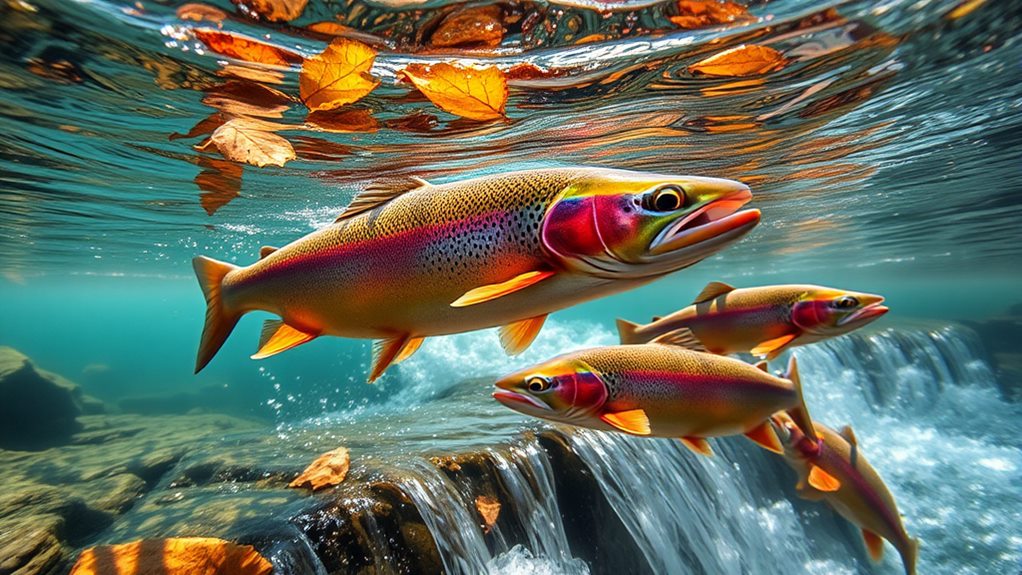
A trout's survival depends heavily on its spawning migration patterns, with different species commencing on these vital journeys at various times throughout the year. You'll find that water quality plays an essential role in determining where these remarkable fish choose to lay their eggs.
| Species | Spawning Season | Migration Distance |
|---|---|---|
| Rainbow | Spring | 2-5 miles upstream |
| Brook | Late Fall | 1-3 miles upstream |
| Brown | Early Fall | 3-6 miles upstream |
| Cutthroat | Spring | 2-4 miles upstream |
When it's time to spawn, you'll notice trout heading upstream to find pristine gravel beds in cold, clean waters. They're incredibly particular about their spawning grounds, and they'll travel several miles to find the perfect spot. Once they've completed spawning, they'll move downstream to quieter waters that provide better protection during winter months.
You'll see different species making these journeys at various times throughout the year. For instance, while brook trout prefer to spawn in late fall, rainbow trout wait until spring. These timing differences help reduce competition for prime spawning locations and promote better survival rates for their offspring.
Stream Flow And Depth Variations
Stream flow and depth create dramatic shifts in trout behavior beyond their spawning patterns. You'll notice that these fish are constantly adapting to changing water conditions, moving between different stream environments as the seasons progress.
Using essential fishing resources like mobile apps can help track these seasonal movements effectively. When spring arrives, you'll find trout seeking shelter in deep pools as snowmelt increases water flow, giving them stable places to rest and feed without fighting strong currents.
Here's how stream conditions affect trout movement throughout the year:
- Spring brings high water levels, pushing trout toward slower, deeper areas where they can conserve energy.
- Summer heat forces them to relocate to cooler, oxygen-rich waters with steady stream flow.
- Fall's lower water levels concentrate fish in specific zones, making them adapt their feeding patterns.
- Winter conditions drive trout downstream to find deep pools with minimal ice coverage.
These seasonal changes in stream flow and depth aren't just minor inconveniences – they're vital factors that determine where you'll find trout at any given time.
Understanding these patterns helps explain why you might find a productive fishing spot completely empty when you return a few months later.
Winter Deep Pool Selection
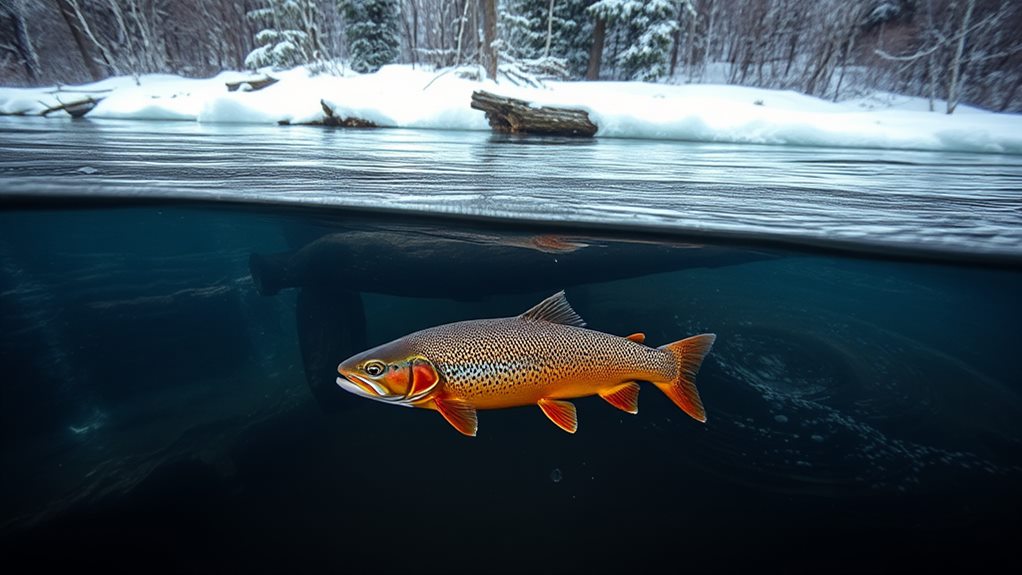
Once winter's grip tightens on streams, trout instinctively seek out deep pools and long runs that provide shelter from harsh conditions.
You'll find these fish gravitating toward areas where the current slows down, particularly in places with stable ice coverage that offers protection from both predators and the elements.
After the spawning season, you'll notice trout making their way downstream to find quieter waters.
They're looking for spots that combine slower currents with plenty of cover, and that's where beaver ponds come into play.
These natural sanctuaries offer exactly what trout need to survive the winter months – deep, calm waters with consistent conditions.
If you're trying to understand winter trout behavior, pay attention to areas with submerged logs and vegetation.
These spots aren't just random hiding places; they're carefully selected winter havens where trout can conserve energy while staying safe from predators.
The combination of woody debris and aquatic plants creates a perfect winter refuge, and you'll often find multiple trout gathering in these protected pools when temperatures drop.
Summer Cold Water Refuges
During scorching summer months, trout instinctively migrate to cold water sanctuaries where they'll find relief from rising temperatures and declining oxygen levels.
You'll notice these fish seeking refuge in deeper pools, spring-fed tributaries, and shaded areas that offer the cooler conditions they need to survive.
While streamer fishing can be effective during early mornings and late evenings when trout are most active, understanding their summer survival strategies will help you locate them more effectively.
Here's what you need to know about trout's summer refuge preferences:
- Deep pools provide cooler temperatures at the bottom, making them prime locations for trout during the hottest parts of the day.
- Spring-fed tributaries maintain consistent cold water temperatures, creating ideal sanctuaries.
- Heavily shaded stream sections offer natural cooling effects and protection from direct sunlight.
- Areas with faster-moving water contain more dissolved oxygen, attracting trout seeking better breathing conditions.
Predator Avoidance Tactics
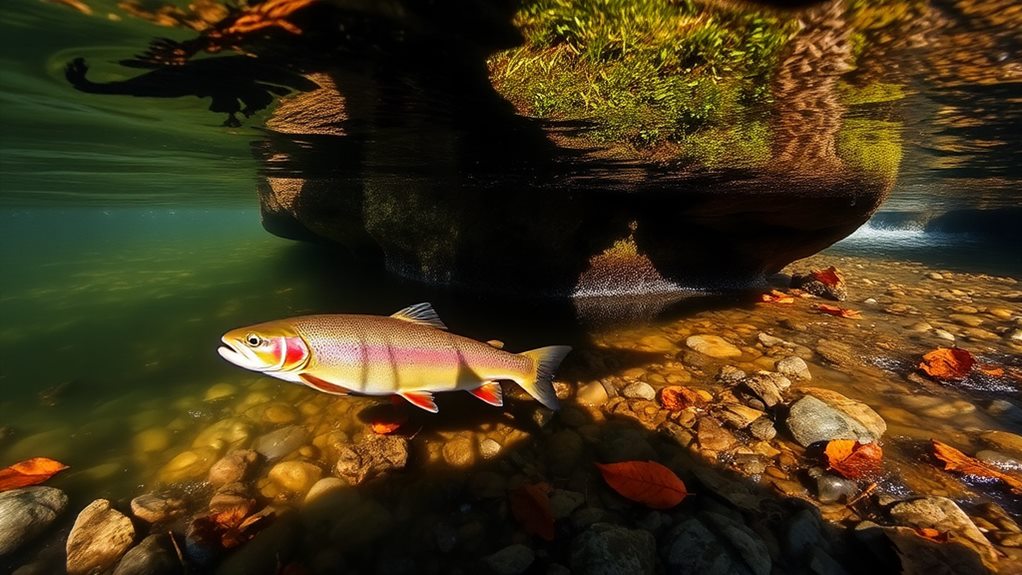
Beyond seeking thermal refuge, trout's seasonal movements are heavily influenced by their need to avoid predators. You'll notice these clever fish employ various tactics throughout the year, carefully selecting streams that offer the best protection from hungry predators looking for their next meal.
During the colder months, you'll find trout gathering in groups within stable habitats, a strategy that helps them survive against larger threats. They're particularly drawn to streams with features that provide excellent cover, such as woody debris, thick underwater vegetation, and undercut banks. These natural hiding spots become their sanctuary when danger lurks nearby.
If you're wondering why trout seem extra picky about their stream selection, it's because they're responding to seasonal changes in water conditions that affect predator behavior. This is especially true for younger, smaller trout, who are most vulnerable to becoming someone else's dinner.
They'll often seek out deeper pools and slower water sections where they can better evade detection. It's a bit like nature's version of hide-and-seek, where finding the perfect hiding spot can mean the difference between life and death.
Stream Oxygen Level Fluctuations
In tracking trout movements throughout the year, you'll find that oxygen levels play a crucial role in their stream selection. Stream oxygen levels shift with seasonal change, and you'll notice trout adapting their locations accordingly.
When summer heats up the water, these sensitive fish will search for areas where cooler temperatures maintain higher oxygen saturation. Optimal temperature ranges between 65-75F influence how actively trout feed and move throughout their habitat.
During your fishing adventures, you'll encounter different oxygen conditions that influence where trout gather:
- Spring runoff creates turbulent waters that mix with air, boosting oxygen levels and creating prime feeding conditions.
- Summer's warm temperatures and algae blooms reduce oxygen content, forcing trout to relocate to cooler, well-oxygenated spots.
- Fall brings cooler temperatures and increased oxygen levels, allowing trout to spread throughout their habitat.
- Winter ice coverage can limit oxygen exchange, pushing trout into deeper pools where oxygen levels remain stable.
Understanding these patterns helps you predict where you'll find trout throughout the year.
When water temperatures rise and oxygen levels drop, you'll often discover trout congregating near riffles or spring-fed tributaries where the water remains cool and oxygen-rich. They're pretty clever about finding these sweet spots!
Seasonal Cover And Structure
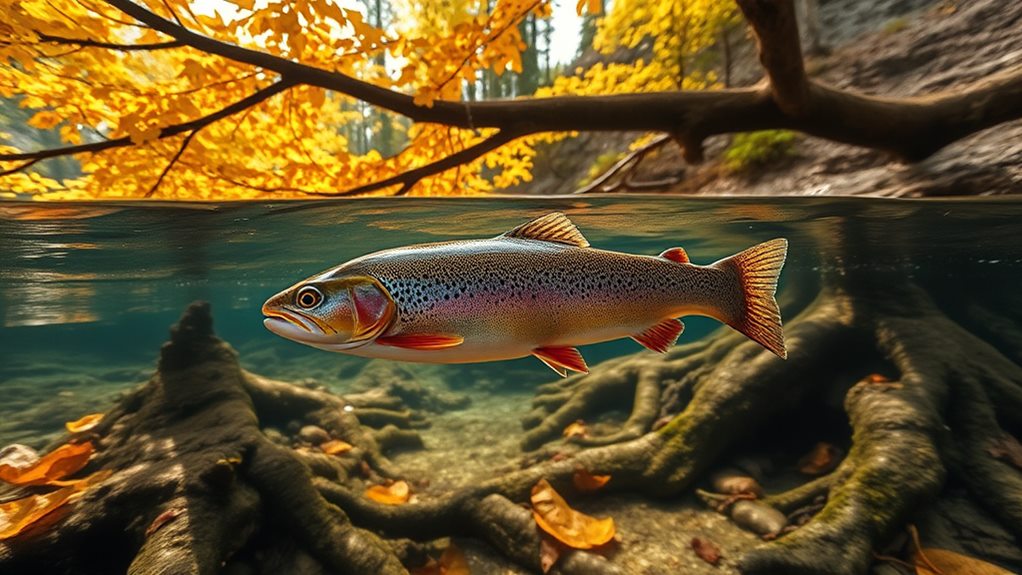
Throughout nature's seasonal cycle, trout actively seek different types of cover and structure to meet their changing needs.
You'll find these adaptive fish making calculated moves as the seasons shift, always in pursuit of the perfect hideout that matches their current requirements.
In spring, you'll notice trout gravitating toward overhanging banks and submerged vegetation, where they can easily access the abundant insect hatches while staying protected.
When summer's heat arrives, they'll relocate to deeper pools and shaded areas, using structure like fallen trees and rock formations to escape both the warmth and watchful predators.
As fall approaches, you'll spot trout moving to deeper, slower sections of the stream, particularly favoring undercut banks that offer excellent shelter and prime hunting grounds for smaller fish.
During winter's chill, these resourceful creatures seek refuge in deep pools and areas with minimal current, where structure like woody debris and beaver ponds provides essential protection from ice formations and persistent predators.
This strategic relocation demonstrates how trout utilize different types of stream structure to maintain their comfort and survival throughout the year.
Energy Conservation Strategies
Three key energy conservation strategies help trout survive the demanding seasonal changes they face.
You'll find these remarkable fish adapting their behavior to minimize energy expenditure, particularly during the challenging winter months. When temperatures drop, they'll seek deeper pools where the water stays more stable, and they'll greatly reduce their movement to conserve precious energy.
In winter, you'll notice trout employing these vital energy conservation tactics:
- Slowing their metabolism to require less food, while relying mainly on drifting insects
- Moving downstream to quieter waters after spawning, reducing the energy needed to fight currents
- Seeking shelter in protected areas like beaver ponds, which offer safety from predators
- Forming pods with other trout to minimize individual energy use through collective movement
You'll see these strategies play out as the seasons change, with trout instinctively knowing when to shift between different habitats.
Their ability to adapt their energy conservation approach helps them thrive even when food becomes scarce and temperatures plummet.
Frequently Asked Questions
What Month Are Trout Most Active?
You'll find trout most active from April through June and again from September to November. They're energetic during spring's insect hatches and fall's pre-winter feeding, especially during mid-morning to early afternoon hours.
Why Do Brook Trout Change Colors?
You'll notice brook trout change colors primarily for spawning, when males display vibrant reds and oranges to attract mates. Their diet and habitat also influence coloration, while seasonal changes affect their appearance throughout the year.
Do Trout Travel up Stream?
Yes, you'll find trout regularly travel upstream during spring and summer for better feeding, cooler waters, and spawning. They'll make these upstream journeys when environmental conditions trigger their natural migration instincts.
Why Are Some Rainbow Trout More Silver?
You'll find rainbow trout become more silver due to their environment, diet, and genetics. The water's clarity, what they're eating, and their natural strain all influence how silvery they appear.



